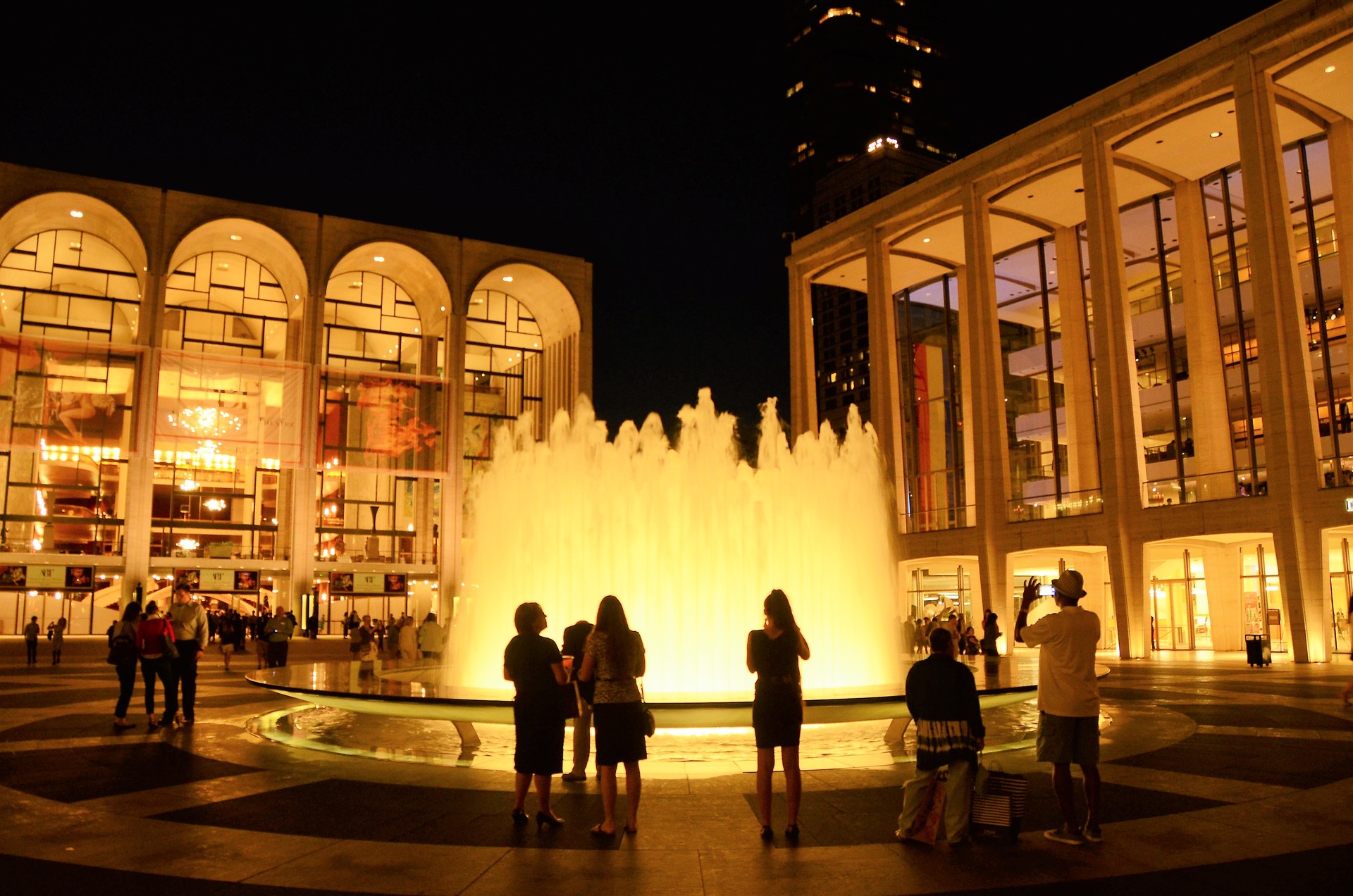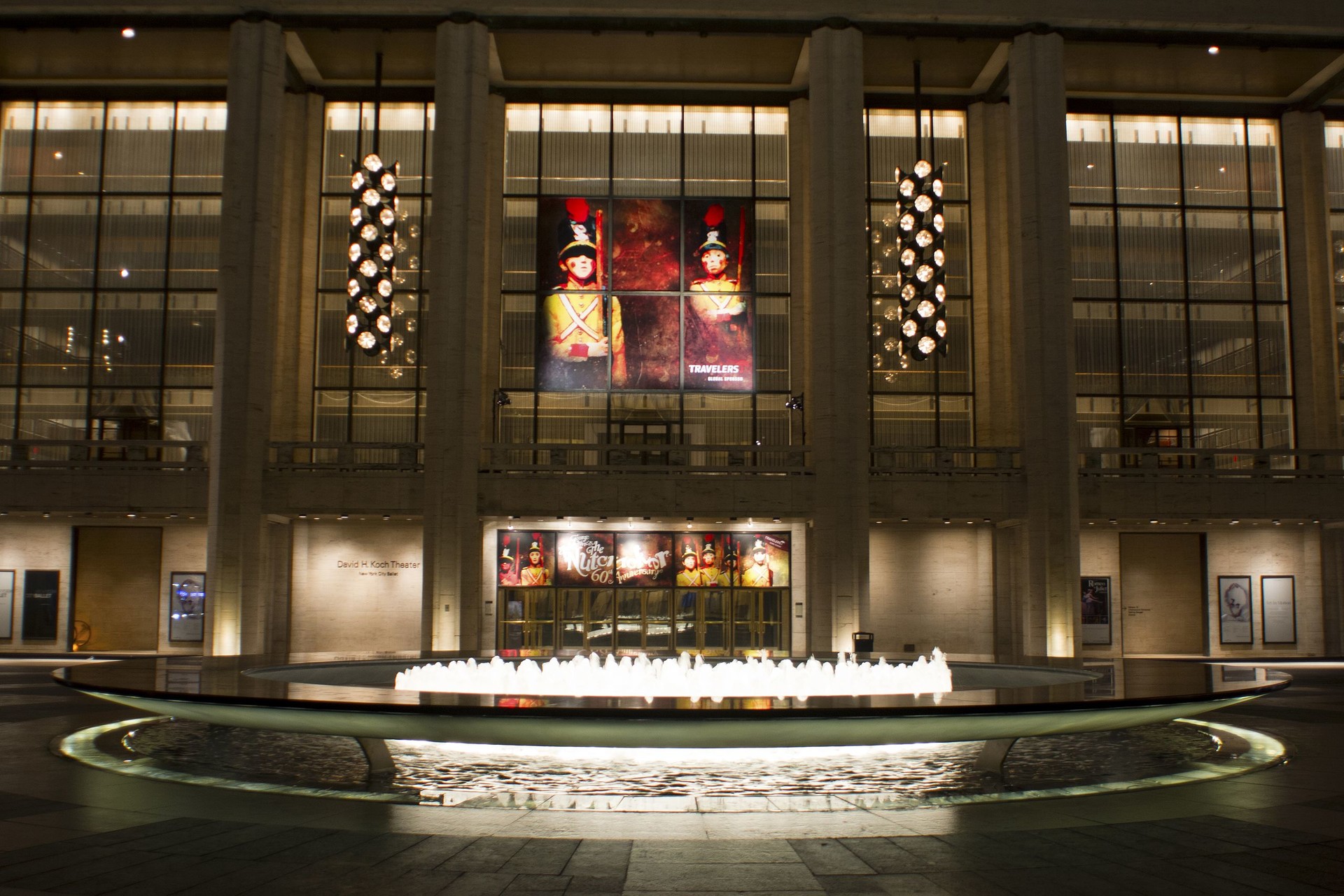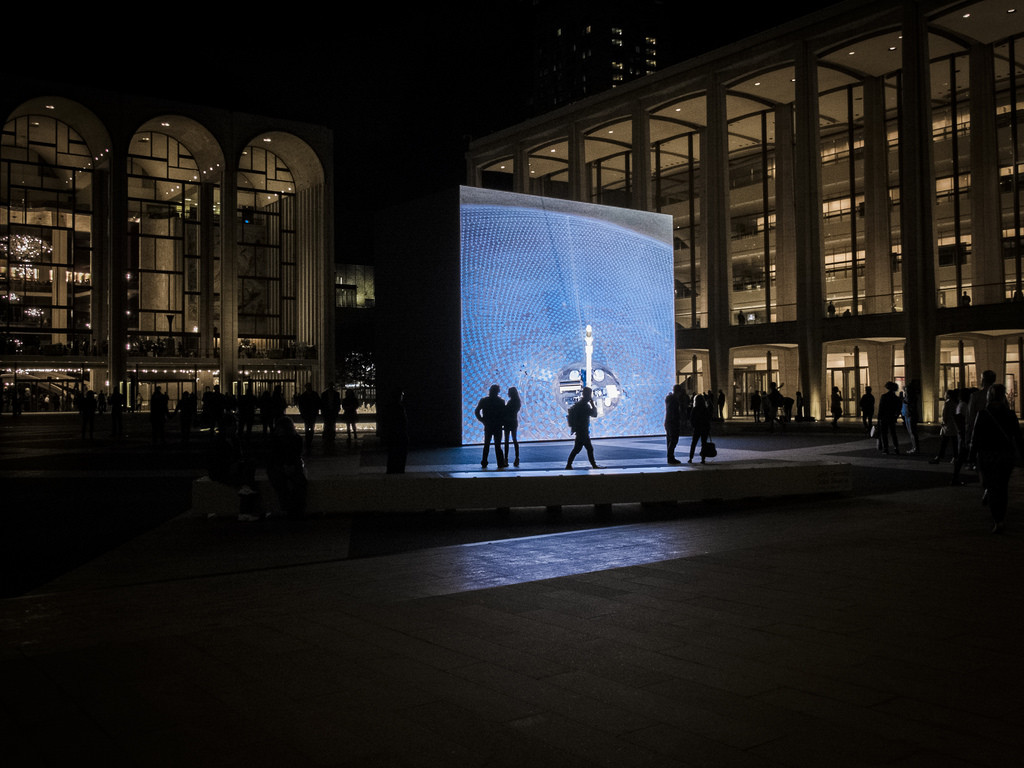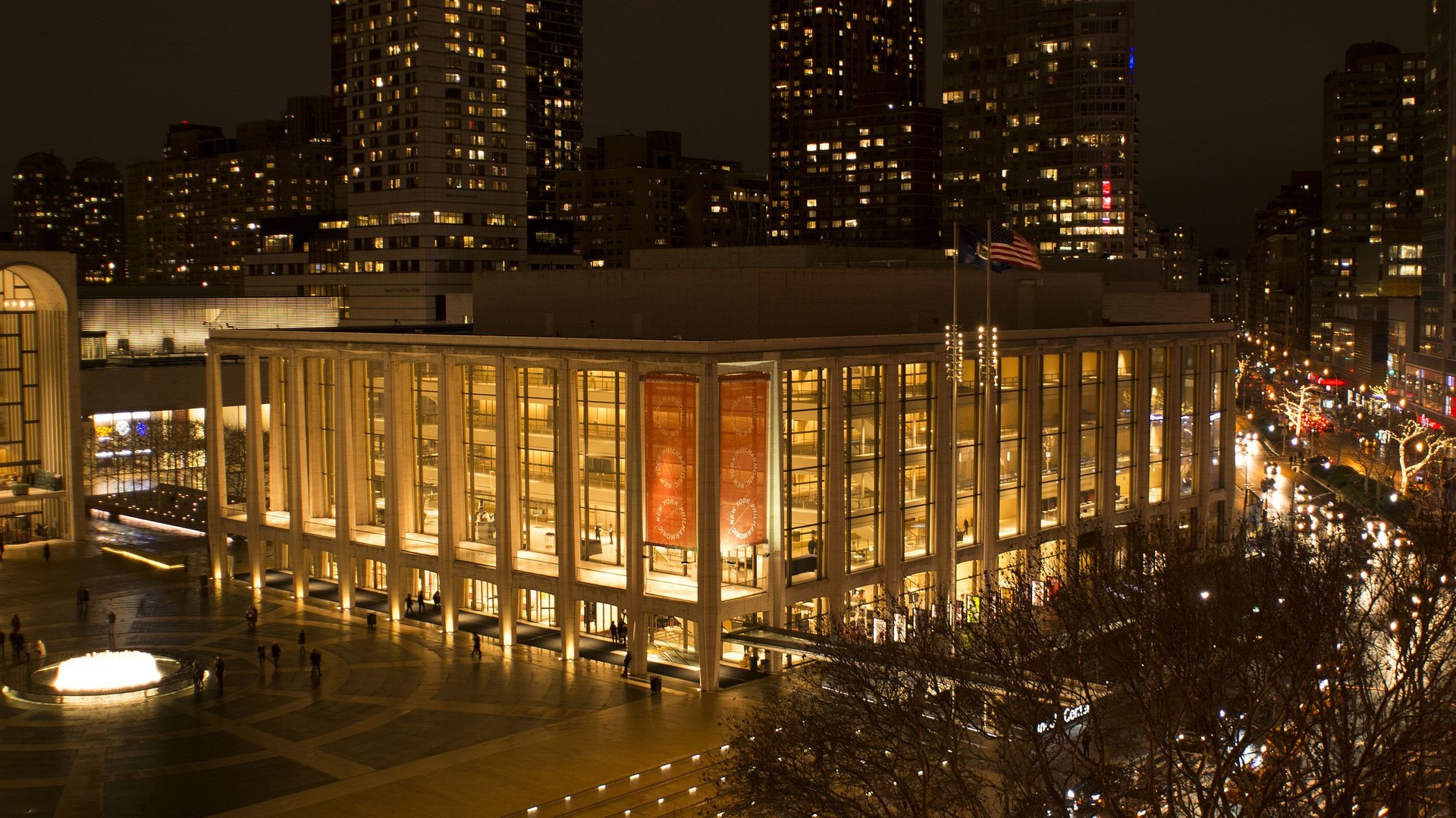Lincoln Center
- Address: 10 Lincoln Center Plaza, New York, NY 10023, Estados Unidos
- Tags:
 What to see New York,
New York,
United States
What to see New York,
New York,
United States
- Telephone: +1 212-875-54
- Website: lc.lincolncenter.org
Lincoln Center
Lincoln Center, Inc. is an enormous centre for the theatrical arts in the city of New York. The organisation is the owner and manager of the twelve resident organisations situated within the Lincoln Center, and is also the organiser of concerts and theatrical productions. The Lincoln Center is situated across more than 16 acres of land in the centre of Manhattan. Concert halls in the Lincoln Center include:
- Metropolitan Opera House
- Avery Fisher Hall
- New York State Theatre
- and, the Vivian Beaumont Theatre.
Resident organisations in the Lincoln Center include:
- New York Philharmonic
- Metropolitan Opera
- New York Opera
- Film Society of Lincoln Center
- Jazz at Lincoln Center
- Chamber Music Society of Lincoln Center
- New York City Ballet
- School of American Ballet
- Juilliard School
- New York Public Library for the Performing Arts
- and, the Lincoln Center Theatre.
Whilst the resident organisations retain their own management autonomy, the groups share the funds that the Lincoln Center raises, and are represented on the Board of Directors of the Lincoln Center. The Lincoln Center's financial support comes from concert revenue, rent rates, and donations from individuals, private foundations and corporations. The constituent groups at the Lincoln Center put on some 5, 000 concerts and performances a year, and the Center serves up to 5 million visitors and patrons. The Lincoln Center serves an additional 200, 000 students a year through its education programmes. The Lincoln Center is also the home of many free outdoor events like 'Lincoln Center: Out of Doors' and 'Swing: a summer's night'. The Lincoln Center also reaches an audience of up to 35 million viewers through its ongoing live series of broadcast performances at the Center.

When the idea of the Lincoln Center was conceived in the middle of the 1950s, it was the first huge arts complex in the country. Alan Rich, in the Lincoln History Centre, declared that it would be something "to turn back the clock to a Medici Palace in Renaissance Florence" to find something comparable in the world at the time that the Lincoln Center was designed. Lincoln Center came about as the convergence of a trio of needs and circumstances. Firstly, the Metropolitan Opera, New York's venerable opera company, had decided to leave behind its inadequate concert hall and went in search of space to build a new one. Secondly, the New York Philharmonic, which is the name of the city's orchestra, was also searching for a new home, as their rented venue, Carnegie Hall, was set to be demolished in 1959. The fundamental third element that brought the Lincoln Center to life was the planned obliteration of several Manhattan housing blocks. The area, known as Lincoln Square, was a four-block square between 62nd and 66th Streets, bounded by Broadway, Columbus and Amsterdam Avenue. Home to more than 1, 600 families, the area was considered to have deteriorated, and had caught the attention of New York "master builder", Chief of Urban Renovation, Robert Moses. The leaders of the Philharmonic and the Met, as the opera company called itself, met with the philanthropist, John D. Rockefeller III, who was interested in doing something for the arts, for initial talks in 1955. Rockefeller and others were involved in the project of a European tour in 1956, visiting other cultural capitals, and when they returned, it was decided that the construction of a large combined performing arts complex to house the opera company, the Philharmonic, and possibly other arts groups, was a feasible plan.

Lincoln Center, Inc. was founded in 1956 as a non-profit organisation. When it began, the group was essentially just a name, as they had no money, no staff, nor property. In 1958, the group bought one of the four city blocks - a 14 acre parcel of New York City - with donated funds. During the next year, residents of Lincoln Square were relocated, and in May 1959, the group held a lavish ceremony, with the President Dwight Eisenhower waving the green flag. At this time, the member organisations of the Lincoln Center included the Philharmonic and the Met, each of whom obtained their own auditorium, the Juilliard School, and the New York Public Library, which was to have a special performing arts library. Lincoln Center also hoped to have a resident theatre company, as well as a ballet company.
Lincoln Center went through many design phases. The company bought more land, expanding its pocket of land to more than 16 acres. The general design of the complex was in the hands of the architect, Wallace K. Harrison, who also designed the Metropolitan Opera House. Philharmonic Hall (now Avery Fisher Hall) was designed by Max Abramovitz; Philip Johnson designed the hall for the ballet company, which came to be known as the New York State Theatre; Pietro Belluschi designed the building for the Juilliard School and the Chamber Music auditorium, Alice Tully Hall; and the other iconic architect from the mid-century, Eero Saarinen, designed the Vivian Beaumont Theatre. The architects successfully managed to work together to produce a series of impressive buildings arranged around a central square. The buildings were completed at different times, with the Philharmonic being the first to open in 1962.
Philharmonic Hall opened with a huge concert directed by Leonard Bernstein on 23 September 1962. The orchestra had marked its first season in its new home, commissioning new works by leading composers like Aaron Copland, Paul Hindemith, Samuel Barber, and the orchestra's very own director, Bernstein. However, despite the evident pride of the orchestra in its new home, not much time passed before the mood dampened. The public and the orchestra members both found the acoustics of the Philharmonic to be dry and inconsistent, which was a bad comparison with those of the beloved Carnegie Hall. Over the following few years, the Philharmonic suffered through various and extensive repairs to fix the aforementioned acoustics. The original cost of the hall had been projected at $5 million. This amount, however, had risen to more than $14 million before the hall's opening, and the later work added exponentially to the cost of the building.

The other buildings were completed one by one. The landmark fountain was completed in 1964, just a few weeks before the New York State Theatre was to open. The Vivian Beaumont Theatre was completed in 1965, just like the New York Public Library and the Performing Arts Museum. That year also saw the installation of two huge outdoor sculptures in the square: a figure of Henry Moore, and an Alexander Calder piece. The Metropolitan Opera House opened its doors in 1966. Just like the Philharmonic, the Metropolitan Opera House had cost significantly more than its proposed budget prior to its construction. It was first projected at $15 million, which later saw this amount more than double to $37. 4 million for its completion, in part because the room was being constructed over foundations that had a tendency to flood. In 1969, the Lincoln Center added Damsrosch Park and the sonic shell of the Guggenheim Museum. That year, the Juilliard School was finally completed.
The list of donations that made all of this possible included many rich, private citizens, huge charitable foundations and leading businesses. John D. Rockefeller, Jr., headed the list of individual donors, and many members of the Rockefeller family also contributed substantially to getting the Lincoln Center built. Important donations from foundations included: the Ford Foundation; the Alfred P. Sloan Foundation; the New York Foundation; the Rockefeller Foundation; and, dozens of others. Many of the country's most important businesses gave money to the Lincoln Center in its first few years, including: General Motors Corporation; International Business Machines; Chase Manhattan Bank; Manufacturers Hanover Trust; Texaco; Shell Companies, Inc.; and, many others.

In 1970, Amyas Ames became the new President of the Board of the Lincoln Center. Ames, who earned his living at the investment firm Kidder, Peabody, had participated in the planning of the Lincoln Center from its inception, and he continued to be a firm defender of the arts during his mandate as President, which ended in 1981. The Center continued to add new components in the 1970s and expanded its events programme. In 1972, the Chamber Music Society became a resident organisation at the Lincoln Center, adding to the variety of musical offerings that were already on offer with the Philharmonic and the Met. The Chamber Music Society's performance space was Alice Tully Hall, the name of a generous patron. Two years later, the Lincoln Center Film Society became a constituent member. In 1976, the Lincoln Center televised the first of its live broadcasts on the nation's System for Public Broadcasting (PBS), the popular live programme from the Lincoln Center. This television series continued until the 2000s, and brought millions of viewers to its concert halls in Lincoln Center. Philharmonic Hall was renamed Avery Fisher Hall in 1973 in recognition of a very important donation. They continued working on the hall's acoustics, and in 1976, the stage space closed for some time, to give way to important reconstruction work. This final re-dp seemed to finally satisfy the critics of the hall, at least for some time anyway.
The constituent organisations of the Lincoln Center seemed to prosper in the new performing arts complex, despite some initial difficulties, like the do-it-yourself acoustics in progress in Avery Fisher Hall. The New York Philharmonic and the Metropolitan Opera had fulfilled their dreams of having their own permanent homes. The New York City Ballet, an incubator of American dance, became a legendary company under the choreography of George Balanchine in the Lincoln Center. Other groups, like the Film Society, returned to life in its new space, and were capable of offering the public of New York more than had been possible in a smaller, yet more central venue. The notable exception was the Lincoln Center Theatre Company, which stumbled along from the start, hadn't been in existence for many years, and really didn't start to flourish until the middle of the 1980s, much later than other groups at Lincoln Center had established themselves.
The Repertoire Theatre differentiated itself from the other groups at Lincoln Center in the way that it was created to occupy the space, instead of being a pre-existing organisation that found a new home. It was conceived as a showcase of North American playwrights, and celebrated its first outdoor season in Washington Square during 1963 and 1964, whilst its space, the Vivian Beaumont Theatre, was under construction. This first season was directed by a pair of directors, Robert Whitehead and Elia Kazan. Kazan, a noteworthy film director, and Whitehead, who worked on Broadway, who had no experience in directing a repertoire theatre. Later, however, after a disagreement with the theatre's management, the pair left. The next season, which began in Autumn 1965, was directed by another pair of directors, Jules Irving and Herbert Blau. Their efforts were not appreciated by New York theatre critics, and their season also ended in a bitter exit, with Blau returning to California.

In 1973, Irving left his position to Joseph Papp, who was recognised for his public theatre and the Shakespeare Festival of New York. Papp stayed until 1977, putting new American works into two theatres at Lincoln Center, the Vivian Beaumont and the smaller Mitzi Newhouse. However, it was difficult to find a balance between Papp's vision and the more conventional expectations of Lincoln Center. With nobody feeling very happy, Papp resigned. Having no other director in line to take Papp's place, the Repertoire Theatre "stayed in the wings", or it abstained from putting on theatre works, in theatre jargon. The theatre reopened for one season in 1980, under the direction of Richmond Crinkley. This season, just like many others before, was not a critical success. Crinkley remained in the job, although the Vivian Beaumont "stayed in the wings" for many more years. Crinkley wanted to renovate the theatre - a change in the stage layout. This plan gave rise to conflicts with the Board of Directors of Lincoln Center, who wanted the theatre company to draw up an artistic vision and a calendar of works before worrying about the physical structure of the playhouse. All of this came to a head in August 1983, when the Board of Directors of Lincoln Center moved to cut the theatre company from the Center's general funds, and prohibited the business from using the name, 'Lincoln Center Theatre Company'. Whilst the Lincoln Center Board of Directors had granted its constituent members autonomy with regards to its artistic decisions and its day-to-day operations, it seemed to feel obligated to intervene at this point and take drastic measures.
In 1985, Richard Crinkley was replaced by Gregory Mosher, a veteran of the Goodman Theatre in Chicago. Mosher left to one side his predecessor's pressures for programming and renovation, and produced a successful season of theatre works in 1986 sponsored by Lincoln Center. For 1988, the theatre was routinely selling, and the theatre company had made some $35 million in ticket sales. After a very slow start, the Lincoln Center Theatre Company had finally established itself in the eyes of the New York public.
At the end of the 1980s, Lincoln Center Inc., had taken on a new role, one that was much further away from what its creators had first forecasted. The non-profit organisation was much more than owner and administrator of a performing arts complex. The society had become an arts producer, yes, as it had widened its New York concert season to be a year-long affair. In 1964, the Lincoln Center produced, for the very first time, its series, Great Interpreters, with a schedule of 12 concerts. At the end of the 1980s, the Great Interpreters series had increased to 75 to 80 concerts a year, a huge increase. Lincoln Center also produced many summer concert events, like its festival Mostly Mozart and Lincoln Center: Out-of-Doors. The center managed and promoted these series, and others, itself, like its contemporary music event, Serious Fun! and a Classical Jazz series. At the end of the 1990s, the Lincoln Center was open 52 weeks a year, and its summer music and dance events attracted crowds of 10, 000 to this outdoor square.
Although it seem like a good business in keeping its halls full all year round, the Lincoln Center would still not break-even through its events alone. In 1990, the business calculated that it would need $7, 500, 000 to put on the concerts it produced, thinking about honours for the artists, the entrance fees it had to assume, and other staff, publicity, and all the costs related to operating its concert halls. Ticket sales only covered $4. 5 million of the total cost. Even the events with sold-out tickets with very favourable critical reviews could lose hundreds of thousands of dollars because the ticket sales would simply not cover the costs. In this way, the company continued to depend heavily on its donations. Lincoln Center raised money from what was called the Consolidated Corporative Fund. All the constituent organisations shared this fund, in exchange for waving its right to collecting money from their account. Member groups could raise funds for particular projects, but all general donations went through the Consolidated Corporative Fund.

The business seemed to have problems raising large sums of money, however. In 1990, the Lincoln Center spent some $180 million on its new Samuel B. and David Rose Building, which gave the Juilliard School space for dormitories, as well as administration offices. The Walter Reade Theatre was completed the following year. This was a cinema, built with the specifications of the Film Society. In 1994, the Lincoln Center chose a new President of the Board of Directors, the retired opera singer, Beverly Sills. Sills had been one of the country's most popular opera stars, well known from television. A key role of the president was to raise funds, and Sills' reputation and extroverted personality made her ideal for the post.
However, at the end of the 1990s, the Lincoln Center and other arts organisations across the country were feeling somewhat pinched. Although this was a flourishing time for North American corporations, waves of mergers and consolidations meant that, in general, there were less businesses that gave donations and reinforced support for the arts. At the start of 1999, the Lincoln Center announced that it was considered selling a painting by American artist, Jasper Johns, which had been hung in the lobby of the New York State Theatre for the last 35 years. The painting was worth between $10 million and $15 million, which made the idea of selling it a very attractive option. Public outcry lead Lincoln Center to take Johns' painting to auction. The fact that the company would consider doing such a thing simply highlighted the dramatic need for Lincoln Center to raise capital.
At the end of the 1990s, many of the buildings at Lincoln Center were showing their age. Although there were many necessary changes, one of the most urgent was the restauration of the white, marble travertine that formed the facades of the buildings. This material had been eroding badly. The concert halls also needed interior changes to allow for the incorporation of the latest sound and lighting technology. Lincoln Center commissioned studies about the best way to get an important correction underway. In 1999, the company gave rise to a group, the Lincoln Center Constituent Development Project, to coordinate the reurbanisation plans for the whole arts complex. One of the plans first considered by the group was presented by one of the world's most foremost architects, Frank Gehry. Gehry imagined a glass dome filling the main square at Lincoln Center. Lincoln Center President, Beverly Sills, announced to the New York Times that she found the dome idea to be absurd, and that project was discarded.
The Constituent Development Project went through several changes of leadership before a new renovation plan was adopted, presented by the architects, Elizabeth Diller and Ricardo Scofidio. It was expected that the whole renovation process would take ten years, with a budget of $1. 5 billion. New York City gave a contribution of $240 million. After the 11 September 2001 terror attacks, and an important drop in market values, the project's budget was reduced by almost half, with a projection of around $675, 000, 000. The expensive project had both its fans and its critics. Paul Goldberger, who wrote for the New Yorker (7 July 2003) pointed out, however, that Lincoln Center had fallen, tragically, to the bottom of its class: "With the World Trade Center gone, Lincoln Center is the true temple of 1960s grand-scale architecture that New York has left. "

Supervising and paying for its renovation was not the only problem that Lincoln Center found during the 2000s. Its constituent organisation, the New York City Opera, threatened to abandon its home at Lincoln Center, unhappy with the cancellation of their plans to build a new theatre for the opera. The long-standing summer series, Mostly Mozart, found itself in trouble during its 2002 campaign, when contractual negotiations between the musicians and Lincoln Center were broken. But everyone seemed to applaud the series the following summer, with the orchestra under the leadership of new director, Louis Langrée. However, around the same time, constituent founder of Lincoln Center, the New York Philharmonic, all of a sudden announced that it was leaving Avery Fisher Hall and returning to its old home, Carnegie Hall. The orchestra was apparently worried about the cost of Avery Fisher Hall's reconstruction, and came up with a new plan to merge its corporative umbrella with the non-profit organisation that ran Carnegie Hall. The negotiations between Carnegie Hall and the Philharmonic went ahead without the participation of Lincoln Center, and although Lincoln Center rapidly announced that it would have no problem filling Avery Fisher for the 120 nights that the Philharmonic was meant to be there for, the orchestra's exit was obviously a heavy blow. Three months later, the Philharmonic and Carnegie Hall realised that they could not merge their organisations, and the orchestra agreed to stay at Avery Fisher.
At the same time, Lincoln Center went through many changes in personnel at the top. Gordon Davis was named the new President of the organisation in January 2001, but he only served in this position until September of that year. He was succeeded by Reynold Levy. Beverly Sills resigned from her position as President of the Board of Directors in 2002, and was succeeded by Bruce Crawford. Crawford had been President and General Manager of the Met, and was seen as a peace negotiator who would be capable of bringing the fractious constituent members together to the table so that the updates could go ahead. Crawford accepted the post to serve as President for three to five years. He announced his resignation in January 2005. Lincoln Center had raised close to $60 million - $325, 000, 000 of which had been committed to carrying out the first part of its renovation, which was hoped to start in 2006. Meanwhile, Jazz at Lincoln Center had built a new auditorium, Frederick P. Rose Hall, at a cost of $128 million, and it was inaugurated in 2004. Crawford pointed this out as one of this achievements during his brief mandate as President of the Lincoln Center. Lincoln Center still found itself at the start of a huge campaign of fundraising and with the many discouraging challenges of the art complex's renovation in 2005, the road seemed to be a troublesome one. However, Lincoln Center had done the same time and again: planning, construction, revision, fundraising, expansion, and reconstruction over the majority of the 40 years since its original construction.
Photo gallery
Content available in other languages
- Español: Lincoln Center
Rate and comment about this place!
Do you know Lincoln Center? Share your opinion about this place.





















